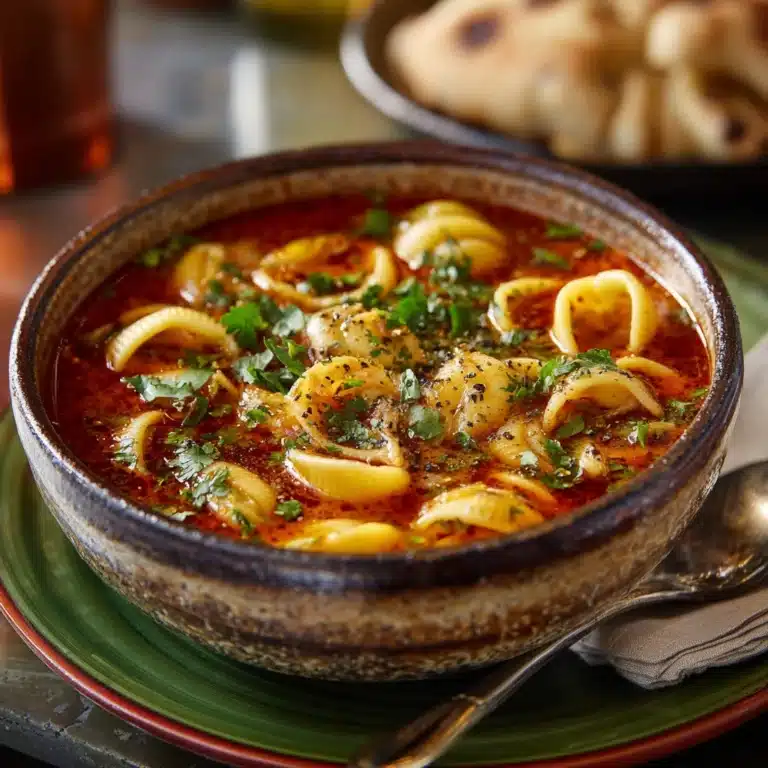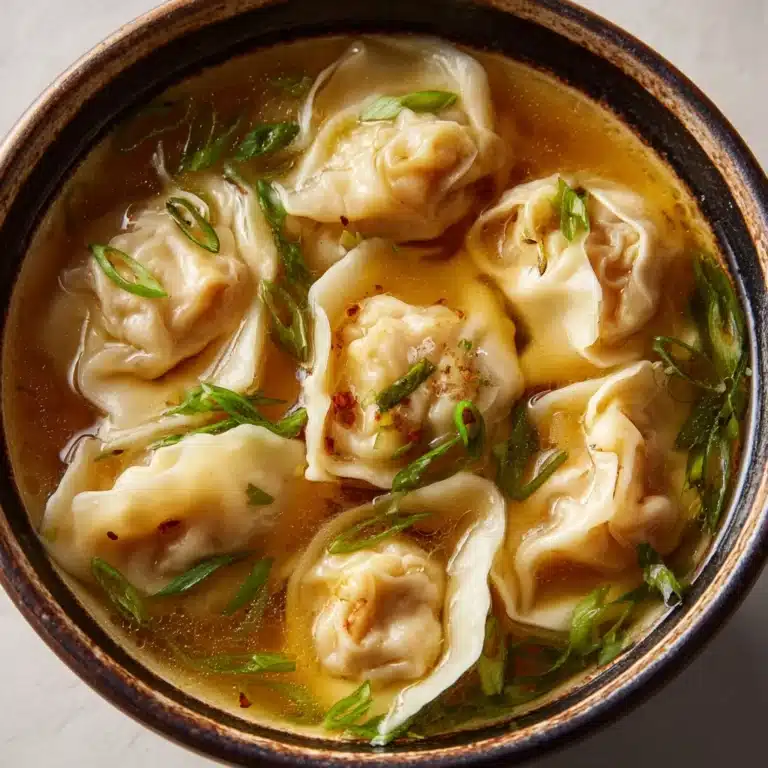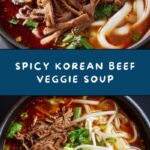Korean Spicy Beef Vegetable Soup Recipe
If you’re searching for the ultimate comfort dish packed with bold flavors and nourishing ingredients, look no further than this Korean Spicy Beef Vegetable Soup Recipe. This hearty and vibrant soup brings together thinly sliced beef, tender vegetables, and a beautiful, spicy broth enriched with gochugaru and gochujang, resulting in a soul-warming bowl that’s both deeply satisfying and seriously delicious. Whether you’re craving a cozy meal on a chilly evening or wanting to impress friends and family with something special, this recipe will quickly become a favorite in your home kitchen.
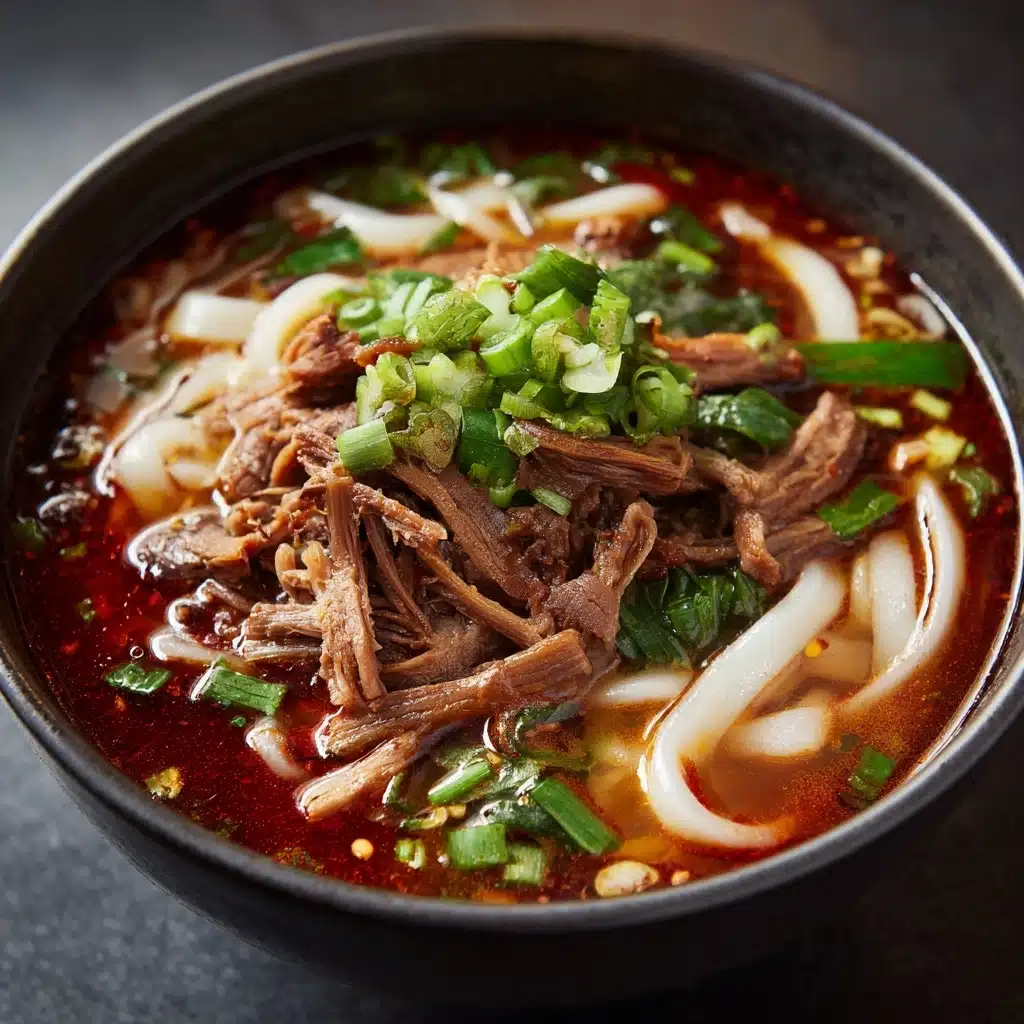
Ingredients You’ll Need
The magic of the Korean Spicy Beef Vegetable Soup Recipe lies in its delightful combination of simple yet essential ingredients. Each one not only enhances the flavor but also adds texture, color, and a genuine touch of Korean comfort to every spoonful.
- Sesame oil: This fragrant oil lends a rich nuttiness and forms the flavorful base of the soup.
- Beef brisket or flank steak (sliced thinly): Thin slices ensure tender bites and help infuse the broth with robust, meaty depth.
- Water: Helps create the perfect consistency for a light yet hearty soup base.
- Beef broth: Intensifies the savory taste and brings added richness to the flavor profile.
- Gochugaru (Korean red chili flakes): The signature spice that adds gentle heat and a gorgeous red hue.
- Gochujang (Korean chili paste): Brings complex, tangy chili flavor and a subtle touch of sweetness.
- Soy sauce: Adds umami depth and perfectly balances the spiciness of the broth.
- Minced garlic: Fresh garlic gives a fragrant punch and unmistakable warmth.
- Grated ginger: Zesty and fresh, ginger brightens the soup and aids digestion.
- Small onion (sliced): Onions cook down into the broth, providing sweetness and body to the soup.
- Zucchini (julienned): Lends a tender bite and lovely green color, soaking up all those spicy flavors.
- Napa cabbage (chopped): This delicate cabbage turns silky in the simmering broth, adding subtle sweetness.
- Bean sprouts: Adds a delightful crunch and freshness right at the end.
- Green onion (sliced): Sprinkled in at the finish for vibrant color and a burst of sharpness.
- Salt (or to taste): Fine-tunes all the flavors for perfect seasoning.
- Black pepper: Just a touch to round out the flavors with mild heat and earthiness.
- Optional: tofu cubes or glass noodles: For making the soup even heartier and more satisfying.
How to Make Korean Spicy Beef Vegetable Soup Recipe
Step 1: Sauté the Beef
Start by heating the sesame oil in a large pot over medium-high heat. Once you catch that savory aroma from the oil, add your thinly sliced beef. Sauté until the meat begins to brown, which not only locks in its juices but lays down a savory foundation for the entire soup. This helps ensure every bite of your Korean Spicy Beef Vegetable Soup Recipe is packed with deep, meaty flavor.
Step 2: Develop the Aromatics
Next, stir in the minced garlic, grated ginger, and sliced onion. Let them cook for 2 to 3 minutes, just until they smell absolutely irresistible and the onions start to look translucent. The aromatics lift the rich flavors of the beef and create an incredibly inviting base to the soup’s spicy broth.
Step 3: Add the Spices and Sauces
Time for the stars of this dish: sprinkle in the gochugaru and stir in the gochujang along with the soy sauce. Mix everything so the beef is well coated with these spicy, tangy elements. This is when you’ll see the soup take on its signature color and begin to imagine how spicy and satisfying your Korean Spicy Beef Vegetable Soup Recipe is going to be!
Step 4: Simmer the Broth
Pour in the water and rich beef broth, then bring everything to a gentle boil. Once it’s bubbling, reduce the heat and let it simmer for 20 to 25 minutes. This step is key—it draws all the flavors together, allowing the beef to become extra tender while the broth deepens in taste and gets infused with those bold spices.
Step 5: Add Vegetables and Final Touches
Now it’s time for the veggies! Add your zucchini, Napa cabbage, and bean sprouts, letting them simmer in the hot broth for another 10 minutes. They’ll become perfectly tender without losing color or crunch. Finish the soup by stirring in the green onion and adjusting the seasoning with a pinch more salt and pepper if needed. For those who want an even heartier meal, toss in tofu cubes or glass noodles at the end—just before serving, so they stay tender and lovely.
How to Serve Korean Spicy Beef Vegetable Soup Recipe
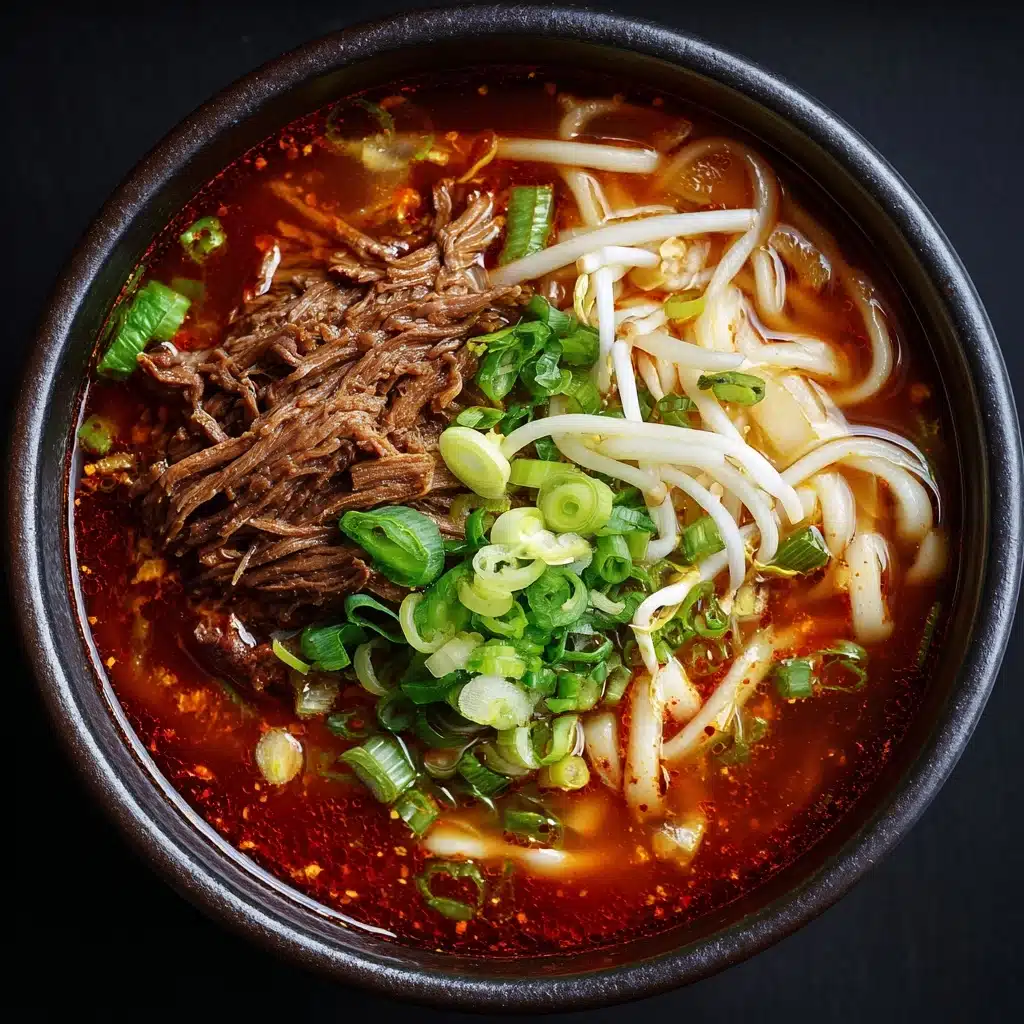
Garnishes
Top your steaming bowl of Korean Spicy Beef Vegetable Soup Recipe with a sprinkle of fresh green onions and, if you love a little extra heat, a few more shakes of gochugaru or a drizzle of chili oil. Toasted sesame seeds also bring a toasty crunch and extra appeal.
Side Dishes
This robust soup is made even better when enjoyed with classic Korean sides like kimchi or a simple bowl of steamed short-grain rice. The tangy, punchy flavors of fermented vegetables perfectly complement the spicy, savory base of your soup, giving you the true Korean experience in your own kitchen.
Creative Ways to Present
Cheer things up by serving the soup in traditional stone bowls, which keep it piping hot right to the last spoonful. For a fun twist, create a DIY soup bar with add-ins like tofu, glass noodles, or thinly sliced mushrooms, so each guest can make their bowl of Korean Spicy Beef Vegetable Soup Recipe just the way they like it.
Make Ahead and Storage
Storing Leftovers
Leftovers will keep beautifully in the fridge for up to three days. Let the soup cool to room temperature, then transfer it into airtight containers. This way, the flavors actually deepen and meld, giving you an even richer experience the next day!
Freezing
If you’d like to save some for a rainy day, pour the cooled soup (without any glass noodles added) into freezer-safe containers or bags, leaving a little room for expansion. It’ll freeze well for up to two months. When you’re ready, defrost overnight in the fridge for the best results.
Reheating
To reheat, gently warm the soup on the stove over low heat, stirring occasionally so nothing sticks to the pot. If you’ve added noodles, you may need to add a splash of water or broth when reheating to keep the soup the right consistency. Microwave reheating works too—just use a microwave-safe bowl, cover loosely, and stir halfway through warming.
FAQs
What kind of beef is best for this soup?
Brisket is the top pick for flavor and texture, but you can substitute with flank steak, stew beef, or even shaved ribeye for quicker cooking and tenderness. Just be sure to slice the meat thinly for the best results in your Korean Spicy Beef Vegetable Soup Recipe.
Can I make this soup vegetarian?
Absolutely! Skip the beef and use a rich mushroom or vegetable broth instead, then add cubed tofu, mushrooms, and extra veggies for a plant-based spin. You’ll still get that bold, spicy flavor thanks to the gochugaru and gochujang.
How spicy is this soup, and can I adjust the heat?
The Korean Spicy Beef Vegetable Soup Recipe is meant to be lively and warming, but you control the heat by adjusting the amount of gochugaru and gochujang. If you’re sensitive to spice, use less of each. For a fiery finish, add an extra spoonful or finish with chili oil!
What other vegetables can I add?
You can absolutely mix things up! Enoki mushrooms, carrots, spinach, or even bell peppers work beautifully in this soup. It’s a great way to clear out the crisper drawer and add more color and nutrition.
Does this soup have gluten?
Traditional soy sauce and gochujang may contain gluten, but you can use gluten-free versions of both to make a completely gluten-free Korean Spicy Beef Vegetable Soup Recipe. Always double-check the labels if that’s important for your diet.
Final Thoughts
This Korean Spicy Beef Vegetable Soup Recipe is the kind of dish that brings joy to the table—warming, nourishing, and incredibly flavorful with every spoonful. I can’t recommend it enough if you’re looking to spice up your usual dinner routine. Give it a try; I’m certain it’ll find a cherished spot in your recipe collection!
Print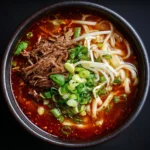
Korean Spicy Beef Vegetable Soup Recipe
- Total Time: 50 minutes
- Yield: 4 servings
- Diet: Non-Vegetarian
Description
Warm up with a bowl of Korean Spicy Beef Vegetable Soup. This comforting and flavorful soup features tender beef, zesty gochujang, and a variety of fresh vegetables, all simmered together for a hearty and satisfying dish.
Ingredients
Beef and Broth:
1 tablespoon sesame oil, 1 pound beef brisket or flank steak (sliced thinly), 4 cups water, 4 cups beef broth,
Seasonings:
2 tablespoons gochugaru (Korean red chili flakes), 1 tablespoon gochujang (Korean chili paste), 2 tablespoons soy sauce, 1 tablespoon minced garlic, 1 teaspoon grated ginger,
Vegetables:
1 small onion (sliced), 1 zucchini (julienned), 1 cup Napa cabbage (chopped), 1/2 cup bean sprouts, 1 green onion (sliced),
Additional:
1 teaspoon salt (or to taste), 1/4 teaspoon black pepper, Optional: tofu cubes or glass noodles
Instructions
- Sear the Beef: Heat sesame oil in a large pot, add beef slices, and brown them.
- Season and Simmer: Add garlic, ginger, onion, gochugaru, gochujang, soy sauce. Pour in water and broth, simmer for 20–25 minutes.
- Add Vegetables: Put in zucchini, cabbage, bean sprouts, cook for 10 minutes.
- Finish and Serve: Stir in green onion, adjust seasoning, and serve hot. Optional: add tofu or glass noodles.
Notes
- For extra heat, add more gochugaru or chili oil.
- You can use stew beef or shaved ribeye instead of brisket.
- This soup pairs well with steamed rice.
- Prep Time: 15 minutes
- Cook Time: 35 minutes
- Category: Soup
- Method: Stovetop
- Cuisine: Korean
Nutrition
- Serving Size: 1 bowl
- Calories: 330
- Sugar: 4g
- Sodium: 720mg
- Fat: 16g
- Saturated Fat: 5g
- Unsaturated Fat: 9g
- Trans Fat: 0g
- Carbohydrates: 12g
- Fiber: 2g
- Protein: 32g
- Cholesterol: 75mg



